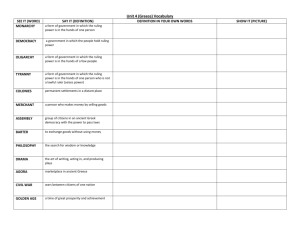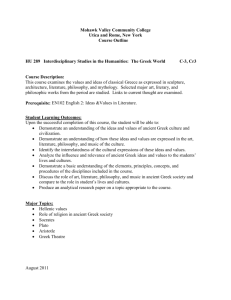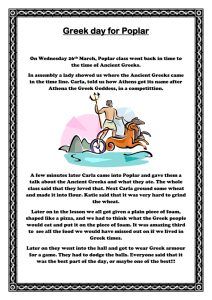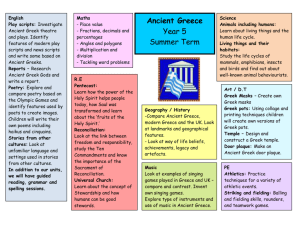Y5/6_Ancient_Greece_scheme_of_work
advertisement
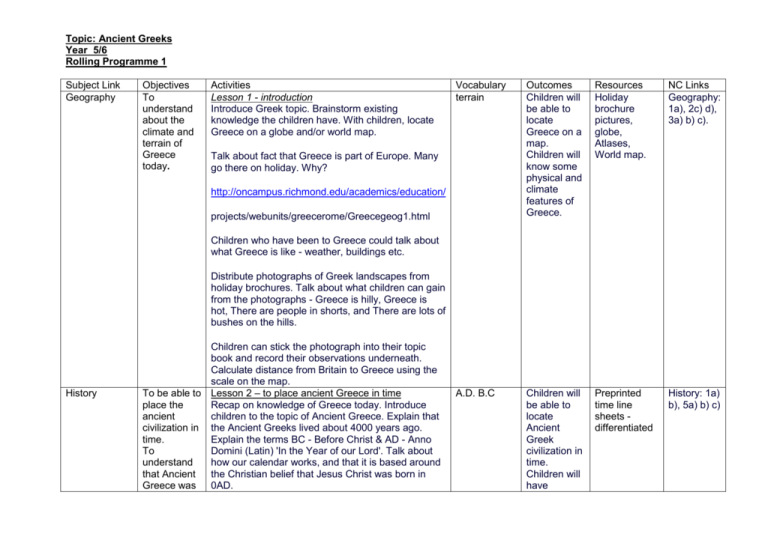
Topic: Ancient Greeks Year 5/6 Rolling Programme 1 Subject Link Geography Objectives To understand about the climate and terrain of Greece today. Activities Lesson 1 - introduction Introduce Greek topic. Brainstorm existing knowledge the children have. With children, locate Greece on a globe and/or world map. Vocabulary terrain Outcomes Children will be able to locate Greece on a map. Children will know some physical and climate features of Greece. Resources Holiday brochure pictures, globe, Atlases, World map. NC Links Geography: 1a), 2c) d), 3a) b) c). A.D. B.C Children will be able to locate Ancient Greek civilization in time. Children will have Preprinted time line sheets differentiated History: 1a) b), 5a) b) c) Talk about fact that Greece is part of Europe. Many go there on holiday. Why? http://oncampus.richmond.edu/academics/education/ projects/webunits/greecerome/Greecegeog1.html Children who have been to Greece could talk about what Greece is like - weather, buildings etc. Distribute photographs of Greek landscapes from holiday brochures. Talk about what children can gain from the photographs - Greece is hilly, Greece is hot, There are people in shorts, and There are lots of bushes on the hills. History Children can stick the photograph into their topic book and record their observations underneath. Calculate distance from Britain to Greece using the scale on the map. To be able to Lesson 2 – to place ancient Greece in time place the Recap on knowledge of Greece today. Introduce ancient children to the topic of Ancient Greece. Explain that civilization in the Ancient Greeks lived about 4000 years ago. time. Explain the terms BC - Before Christ & AD - Anno To Domini (Latin) 'In the Year of our Lord'. Talk about understand how our calendar works, and that it is based around that Ancient the Christian belief that Jesus Christ was born in Greece was 0AD. made up of city states. knowledge of BC and AD Look at how the numbering works for AD & BC. The bigger the BC number, the longer ago it happened. Discuss travel and the city states, boats and sailing etc. the difficulty of being isolated and the lack of communication. Work through with the children placing some Greek events onto a timeline. Children to continue on own timeline. History To understand what is meant by democracy. To understand some of the ideas of people living in Athens and Sparta. Lesson 3 – Athens and Sparta Locate Athens and Sparta on a map. Children to describe physical features of location - near to the sea, by mountains etc. Talk about the fact that these cities were states; they ran their states differently and were rivals. Democracy Children will know that Athens and Sparta were city states that governed themselves. Children will know some differences and similarities between Athens and Sparta. Statement sheets. Resource books (Ginn) History: 2a) b), 4a), 12 tireme, artifacts, Children will understand why Greek fighting ships were important. Children will be able to History: 2a), 4a) b), 12 Look at a scene of Athenian and Spartan life; compare differences and similarities. Focus on homes, buildings/statues, what women/men/children roles were and the size of their army. Explain the term democracy and what it means for us today. Did Athens and Sparta have a democracy? History Read pages 6-8 in Ginn. Discuss differences and similarities, as a class sort out statements from sheet into either Athens or Sparta. Lesson 4 – What made Greeks such great fighters? Recap on ideas that Ancient Greece was split into city states and that Greece is made up of many islands; often to get to different states there was a need to cross water. To infer information about Greek wars and warfare from illustrations and artifact Lead onto why army and ships were so important photographs. city states often fought against each other, the Ginn Pictures of Greek and Persian soldiers. Resource pictures of To study armour and warships. armies needed to cross water and it would take a long time to cross the hills, on foot, with heavy armour. Look at pictures of pottery depicting Greek soldiers fighting, and ships. What information can be gained? Ginn page16 History History To look at the main events and characters of a key battle. To know that a battle may be interpreted in different ways and why this is so. To understand how modern events have connections with the past. Lesson 5 – The story of Marathon Greece and the Marathon, battle with the Persians Persia, Talk about real or fictitious events that will Athens encourage a discussion of interpretation of events by different people: a playground fight where both children involved feel the other is to blame, a goal in a football match described as 'skilful' by one team and 'lucky' by the other. Talk about why different people might interpret events differently and the effect this has on the value of the History recounts that have survived. To be able to deduce information about Greek beliefs and Lesson 6: Greek Gods and Temples Show Mount Olympus on a map and introduce it as the home of the Gods (Page 30 in Ginn). Discuss the Parthenon – the home of Athena (page 10 in Ginn). Discuss the Acropolis. Explain that you are going to tell the story of a battle that took place in Ancient Greece. Enlist children to act out parts of the story to make it more visual. Ask the children to think about how different people might have interpreted the battle and how much we can 'trust' the retellings. Ask the children to decide whether they think a Persian or a Greek recounted this event and give reasons for their thoughts. Acropolis, Parthenon, Mt. Olympus draw information and make conclusions from 'real' evidence. Children will have knowledge of Greek soldier and ship terms. Children will know the main characters and events of a key battle. Children will understand that events can be interpreted differently depending on viewpoint. Children will appreciate that modern events may have connections with the past. Children will be able to deduce information from pottery pottery. Ginn pages 14-15 History: 2c), 3, 12 Story board sheets differentiated? Greek God sheet Eureka tape Greek books for research History: 2a) b), 4a), 5a) c), 12 religious practices from pictures of buildings and pottery. History To learn about the beliefs of Ancient Greeks. - to deduce info about Greek beliefs and religious practices from pictures of buildings and artefacts; - about the beliefs of the ancient Greeks History/English To understand Linked to aspects of English unit on Greek Myths myths and where we gain this information. To know what a myth is. History To be able to Art understand the role of How do we find out about things in the past? From the buildings and pottery. Class to use whiteboards to record what information can be gained from the pictures displayed record on flip chart. and buildings about the religious beliefs of the ancient Greeks. Watch program 2 Greek Gods and temples in Eureka. Check we have it still????? Ginn books http://www.kented.org.uk/ngfl/subjects/history/ webenquiry/greeks/question1.html Lesson 7: Greek Gods Discuss the background to Greek gods and goddesses – explanations for things. Discuss human and non-human qualities. Use powerpoint o show pictures and descriptions of Zeus, Hestia, Demeter, Ares, Poseidon, Aphrodite, Hera, Hades. - complete a fact-file card on a Greek god - research sources (books/internet) to write and make fact-file card. Cut out pictures of various god/desses and write a brief description of their features Frames for lower ability. Higher ability to note the primary sources which were probably used to find this information. http://www.kented.org.uk/ngfl/subjects/history/ webenquiry/greeks/gods.html Lesson 8 - Greek Myths Read together page 32 of Ginn and discuss. Read a Greek myth to the class, such as The labours of Herakles, Theseus and the Minotaur etc. How have these myths been recorded? Children will be able to deduce information from pottery and buildings about the religious beliefs of the ancient Greeks. Herakles, Theseus , myths Record parts of the story on the board to help the children in their independent task. Lesson 9 & 10 – Greek Theatre Discuss page 42 and 43 in the Ginn book. Ask questions for verbal response. Talk about the shape, comedy, tragedy, Dionysus, Children to be able to retell a Greek myth and to understand what a myth is. Storyboard sheets – differentiated. Children will understand the role of Mask templates Elastic History: 2a) b), 4a), 5a) c), 12 Greek myth Pictures? History: 2a), 4a), 12 theatre in Greek life. Children are to recognise the main features of a Greek theatre. acoustics, and presence of an altar, seating, the stage and how it was built in the open air. acoustics Greek theatre and to recognise the main features of it. evaluate, theatre, exaggeration, expression Children will Space..hall develop their speaking and listening skills through practicing and producing their own Greek myth appreciating the conventions of Greek theatre S+L En 1:1,2, 4 Olympics Children will be able to make inferences about the Olympic Games. History: 1b), 2a) c) d), 4a) b), 5a) c) 12 Explain that Ancient Greek theatre originated from a festival held in honour of the God Dionysus. Introduce the different types of plays that were shown - tragedies and comedies. Talk about the elements of each. Ask children to suggest whether the Greek myths they know would be comedies or tragedies. Art supplies for masks Discuss the fact that the masks had to have exaggerated features because of the seating English History Children to develop their speaking and listening skills through practicing and producing their own Greek myth. Children to appreciate and recognise the main features of Greek theatre. Children to make inferences about the Olympic Games. Children to Lesson 11 – Performing Greek myths Remind children of the previous lesson on Greek theatre. How would they have dressed? Discuss dramatic arm movements etc. In their mixed ability groups, children are to practice and rehearse their Greek Myth. Perform with masks made in previous lesson. Lesson 12 – The Olympic Games -Explain the historical background of the Olympics (procedures, ceremonies etc…) -show video from espresso of coverage -chn to recognise this modern day event as a legacy from Ancient Greece. -discuss when, who, where, prizes of modern day Greek information books, photos, internet etc. know why the Olympic Games were important to the Ancient Greeks. olympic games. -Give each group a title to talk about (eg Olympic Creed) with some information - discuss understanding of the title and feed this back to the rest of the class while the rest of the class takes notes on what is being said. Children will know why the Olympic Games were important to the Ancient Greeks. Create their own Olympic games timetable/poster and present it to the class. http://oncampus.richmond.edu/academics/education/ projects/webunits/greecerome/Greecesports1.html Lesson 13: Olympic games event PE Art to investigate and combine visual and tactile qualities of materials and processes to show movement • to use a variety of methods and techniques to show movement • to apply their experience of materials and processes, developing Lesson 14-Action figure sculpture Demonstrate how to use pliers in different ways, bend ends of wire for safety purposes. Ask the children to experiment using pliers to bend the wire. Demonstrate how to make a simple armature, twisting wire in the middle for the head shape, body and legs, add second piece for arms, double wire for strength. Ask the children to make an ‘armature’ for their sculpture by: – using wire to create the movement of the figure, consider joints, balancing the weight, working from original drawings – stapling the wire to a wooden base for stability – building form onto the armature using screwed up newspaper and masking tape − cutting mod roc (plaster impregnated bandages), into thin strips, − soaking in water, modelling form of figure using mod roc. Ask the children to paint the figure when dry. practise techniques for using wire • explore the visual and tactile qualities of wire • develop skills and techniques using mod roc to model form • make a sculpture of a figure using construction and modelling techniques, from original drawings their control of tools and techniques • to match materials and processes to ideas and intentions. and photographs. Art to adapt their work according to their views and describe how they might develop it further • to compare the ancient and modern Olympic games. Lesson 15: Action figure sculpture Ask the children to make considered changes to their work as needed. Discuss what is most and least effective about the work as it progresses. Review finished sculptures. Compare their work with other sculptor’s work. What materials and processes did the sculptors use? How has the sculptor shown movement? Did the use of visual qualities suit the purpose? Look at statues of Greek athletes and Greek gods? What does that tell you about their beliefs, thinking about why the games were held in the first place? Discuss how the ancient Olympic games differed from the modern version. Ask them to suggest the reasons for the differences. This information can be recorded on a grid, with the columns labelled ‘ancient’ and ‘modern’ and the rows labelled ‘Location’, ‘Reason for games’, ‘Events’ etc. History To be able to Lesson 16 - Everyday life understand Read through relevant parts of Ginn pages 20-29. adapt their work as needed • answer key questions to review the effectiveness of their own work • compare their work with other sculptor’s work as part of the process of evaluation • suggest similarities and/or differences between ancient and modern games. Children will be able to Ginn books History: 2a) b), 4a), 12 aspects of Greek everyday life and the types of work done by ordinary Greek Citizens. As a class, list the types of jobs that took place in Ancient Greece. History English To discover the links between the Greek alphabet and our own. A range of subjects To experience Greek activities. To understand how we gain evidence from the past. Lesson 17: Greek alphabet Prior to this lesson (in literacy) conduct an activity about the origin of words and dicover which words /prefixes /suffixes came from Greek language. Produce Greek word bank. Discuss importance of writing for recording. Tell chn origins of Greek language. Examine the Greek alphabet noting similarities and differences. Discuss sources of evidence – pots, sculptures, coins. Translate some Greek letters to make words. Chn examine copy of Greek coin with Greek god on it written in Greek. Chn use letters to decipher who the god is. Lower ability chn write their name using Greek letters, while the other chn write a short message for a partner to decode. Children to experience a range of activities for the afternoons. Perhaps they could make Laurel wreaths to wear in preparation? As a year group these activities could be rotated: Food tasting – feta cheese, olives, olive bread etc. Pot painting Plate making The Olympic games Watch Eureka program 4 on Everyday life. Discuss. Obviously with support and extension where appropriate. list Greek jobs, to understand why they needed to be done and appreciate the nature of Greek life. Consolidate project through practical and fun activities. Extra-curricular Useful websites http://www.britishmuseum.org/explore/families_and_children.aspx http://www.kented.org.uk/ngfl/subjects/history/qca/greece.htm




